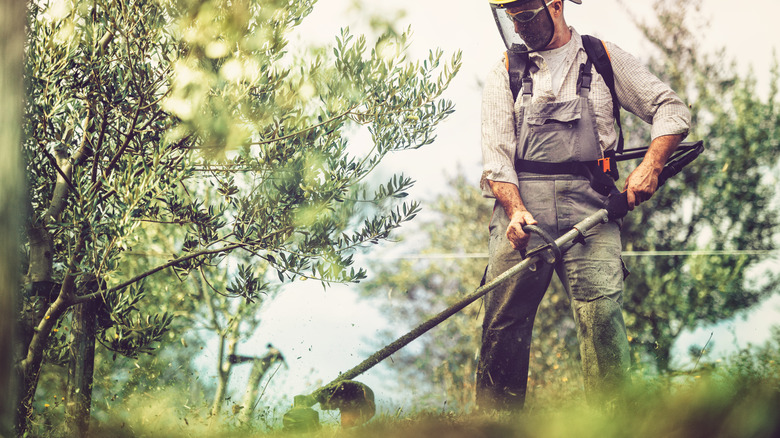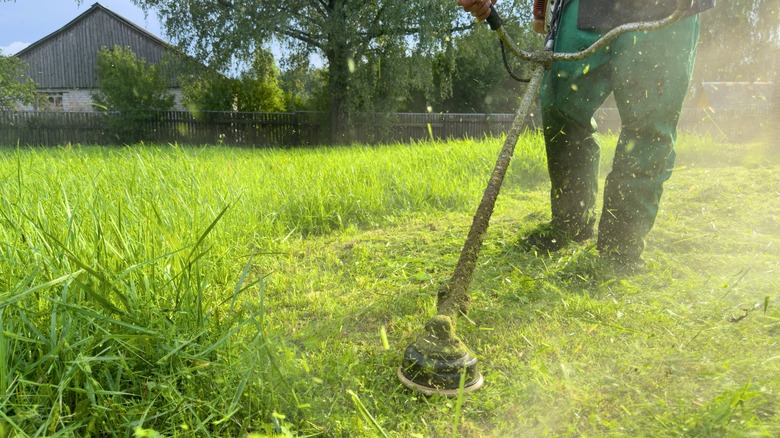The Handy Way You Should Be Using Your Weed Whacker On Your Lawn
When it comes to keeping your lawn looking its absolute best, it's all about the details. And let's be honest, nothing ruins the look of a perfectly mowed lawn quite like blunt or unkempt edges around your fence, curb, or driveway. That's where your trusty weed whacker comes into play, but not in the way you might be used to. You see, a weed whacker, or weed eater, as some call it, is often relegated to the role of tackling those pesky weeds or the tall grass that your lawn mower glances over. Yet, this tool can do so much more, particularly when it comes to creating those crisp, tapered edges that give your lawn a polished, professional appearance.
Tapering is a nifty technique that takes the concept of edging a step further. Instead of just creating a hard line between your lawn and the sidewalk or driveway, tapering introduces a subtle, angled cut that merges the edge of your grass into the main body with a gentle slope. It's like giving your lawn a soft, natural-looking border that doesn't just abruptly stop at a fence or a retaining wall. Before getting started, it helps to have a solid understanding of how your weed whacker works and get a grip on how to handle the tool. You'll also need to familiarize yourself with the manufacturer's instructions. This will keep you out of harm's way and ensure your weed whacker lives a long and productive life.
Mastering the technique: creating a tapered edge
Before you get started, wear some protective gear. This includes eyewear to shield yourself from any flying debris. Ear protection is also a good idea because these machines can get pretty loud. Once you're all suited up, it's time for the main event: tapering your lawn edges. The trick here is all in the angle. Many trimmers come equipped with an attachment specifically for edging. However, even if your model lacks this feature, you can still manage to edge effectively. All you need to do is hold the edge of the machine so that the line hits the grass at an angle. This approach prevents you from cutting off too much grass in a straight line and achieves a smooth transition between the object and the lawn.
Also, remember that you're aiming to give your lawn a crisp, clean outline. Plunging your edger too deep can spell disaster for the delicate roots of your turf, potentially leading to unsightly patches where the grass might struggle to survive, let alone thrive. So, keep it superficial, just skimming the edge enough to define it without disrupting the soil and root systems beneath. Lastly, remember to keep a steady pace. Moving too fast might result in uneven edges. On the other hand, going too slow could over-trim the area. It's a balance that might take a little practice to perfect, but once you've got it, you'll notice a significant improvement in how your lawn edges look.
Important considerations when using a weed whacker
When using a weed whacker to tidy up your lawn, there are a few rules to keep in mind. First off, ensure the machine is in prime condition: a fresh line loaded, and if it's battery-operated, it should be fully charged. For gas models, check that the fuel tank is filled. This preparation step ensures your tool won't stop mid-task. Also, keep in mind that cutting can be difficult when the soil is overly dry. There's a risk of harming your grass since it might not be able to withstand the stress from trimming, so it's best to avoid cutting during a drought.
Another important factor is keeping your weed whacker clean. After each use, wipe down the device with an alcohol-based cleaner. It's not just about aesthetics; it's also about the health of your garden. This simple step helps prevent the spread of any diseases or fungi from one part of your garden to another, safeguarding your green space. Moreover, don't forget to give the exhausts a thorough cleaning once in a while. These parts can get clogged, affecting the efficiency and longevity of your tool. So be sure to properly remove any grass cuttings or debris. Finally, where you store your weed whacker can make a big difference. A dry environment is ideal. You can opt for your garage or even a shed. Moisture is the enemy here, as it can lead to rust and other issues that might hinder performance.


